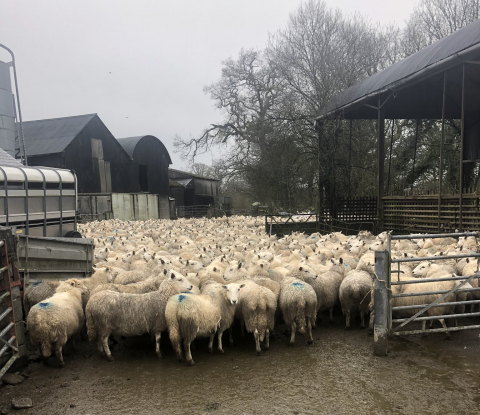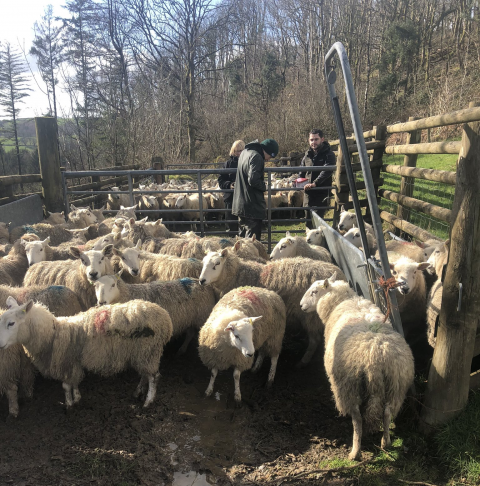Pre-lambing metabolic blood profiling at Glanmynys demonstration site
Blood sampling ewes in late pregnancy is a well-established tool that helps determine if the ration being supplied in late pregnancy is satisfying the ewes’ requirements.
On 2 March 2020, Joseph Angell of Wern Vets, visited Glanmynys, a red meat demonstration site for Farming Connect, to carry out the following:
- Pre-lambing body condition scoring
- Metabolic profiling
- Check feed ration
- Trace element profiling
Pre-lambing body condition scoring
Joseph Angell noted:
“I examined three groups of sheep grazing well managed fields close to the farm. The groups compromised of: single bearing ewes, a group of twin bearing ewes and a group of triplet bearing ewes mixed with ewe lambs and some leaner ewes from other groups. In general, the ewes were leaner than expected despite a good quantity of good quality grass being available.”
The average body condition score (BCS) for all groups was 2.0. Joseph Angell recommended that he would expect the twin and triplet bearing ewes to be at BCS 3.0 – 3.5 and the single bearing ewes and the ewe lambs to be at BCS 3.0.
Metabolic Profiling
The results of the metabolic profiling test carried out showed normal levels of protein and Beta hydroxybutyrate (B-OHB) in the blood of all ewe groups. A proportion of ewes in all groups showed high urea levels. This may be as a result of insufficient energy. Albumin levels were also low in a proportion of all ewe groups which could either be a chronic lack of protein, or a result of a fluke infection.
Check feed ration
Based on the results of metabolic tests and body condition scoring at Glanmynys, Joseph Angell advised feeding all groups of ewes with different quantities. Pregnant ewe lambs should be fed with concentrates (18% protein) at a rate of 0.5kg per head per day, rising gradually to about 1.1kg at lambing. Twin-bearing ewes should receive supplementary feeding of 0.25kg per head per day of good quality concentrate feed rising gradually to about 0.8kg at lambing.
In addition, ewes may need feeding for a few weeks after lambing depending on how well they are milking.
If ewes are housed, it is important to ensure they have sufficient feeding space so that they can all feed at the same time. The same rule applies for ewes which are fed outside.
Trace element profiling
Trace elements tested for included: copper, selenium, cobalt, zinc and iodine.
For copper and selenium, no supplementation is required at this stage. Over-supply could result in toxicity issues.
Cobalt levels are adequate, however some ewes demonstrated levels which were above average. This could suggest an over-supply of cobalt, therefore there is potential to improve efficiency and lower costs from supplying less cobalt.
On average, zinc concentrations in the blood were marginally low. This is worth looking at in the future when considering pre-tupping supplementation. Zinc is fundamental for immunity.
Based on the data collected, no trace element supplementation is required at this stage. Moving forward, Joseph Angell suggests that further blood samples are taken from the ewes after weaning to establish the needs of the ewes prior to tupping. It is also important to analyse available forage.
Next steps for Glanmynys:
- Offer supplementary concentrate feed in relation to ewe group and recommendations given.
- Keep ewes on good quantity of high quality grass.
- Avoid trace element supplementation at this point.
- Further sampling of ewes and available forage after weaning to establish ewe requirements prior to tupping.
Tips for other farmers:
- Many farmers now see metabolic testing as an essential pre-lambing tool. A significant proportion of lamb neonatal death is directly related to ewe colostrum and milk production and this is determined, in part, by ewe nutrition.
- If ewes are housed ensure they have sufficient feeding space so that they can all feed at the same time. If being fed outside, ensure the feed is well spaced for the same reason.
- Trace element profiling helps determine the need for supplementation, and is a good tool to avoid oversupply, which can lead to toxicity problems and to save on costs of over supplementing.
- Feed ewes a few weeks after lambing if they are low on milk. Low milk yields can increase the risk of mastitis as the lamb chews the teat.
Figure 1. Glanmynys’ ewes
Figure 2. Blood sampling the ewes at Glanmynys


